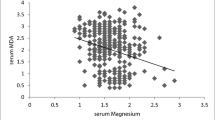Abstract
The purpose of the study was to examine the zinc and iron content of human lenses in different types of cataract and to investigate the possible influence of diabetes on the zinc and iron content of the lens. Iron and zinc of 57 human lenses (28 corticonuclear cataracts and 29 mature cataracts with a mean age of 70.6±16.1 and 74.7±11.1 yr, 41 nondiabetics and 16 diabetics) were determined by atomic absorption spectroscopy. The zinc content of human lenses was significantly increased in mature cataracts compared to corticonuclear cataracts (0.51±0.33 vs 0.32±0.20 µmol/g dry mass, p=0.012). The iron content of mature cataracts was also higher than in corticonuclear cataracts (0.11±0.09 vs 0.07±0.05 µmol/g dry mass, p=0.071). Furthermore, a significant increase of the lens zinc content could be observed with increasing lens coloration (light brown 0.33±0.17 vs dark brown 0.52±0.35 µmol/g dry mass, p=0.032). Diabetic patients seem to have both increased zinc and iron contents in the lens compared to nondiabetic subjects (zinc: 0.45±0.42 vs 0.40±0.22 µmol/g dry mass; iron: 0.12±0.10 vs 0.08±0.05 µmol/g dry mass). These data suggest a possible influence of the lens zinc and iron content on the development of lens opacification. Especially advanced forms of cataract and dark brown colored lenses show significantly increased zinc and iron content.
Similar content being viewed by others
References
C. Kupfer, B. Underwood, and T. Gillen, Leading causes of visual impairment worlwide, in Principles and Practice of Ophthalmology Basic Science (D. M. Albert and F. A. Jakobiec, eds.), W.B. Saunders, Philadelphia (1984).
A. J. Bron, J. Sparrow, N. A. P. Brown, J. J. Harding, and R. Blakytny, The lens in diabetes, Eye 7, 260–275 (1993).
J. J. Harding, Cataract, Biochemistry, Epidemiology and Pharmacology, Chapman & Hall, London (1991).
M. H. Garner and A. Spector, Selective oxidation of cysteine and methioneine in normal and senile cataractous lenses, Proc. Natl. Acad. Sci. USA 77, 1274–1277 (1980).
S. Fu, R. T. Dean, M. Southan, and R. J. W. Truscott, The hydroxyl radical in lens nuclear cataractogenesis, J. Biol. Chem. 273, 28,603–28,609 (1998).
B. Garner, M. J. Davies, and R. J. W. Truscott, Formation of hydroxyl radicals in the human lens is related to the severity of nuclear cataract, Exp. Eye Res. 70, 81–88 (2000).
D. Garland, Role of site specific, metal-catalyzed oxidation in lens ageing and cataract, Exp. Eye Res. 50, 677–682 (1990).
B. Vallee and D. Auld, Zinc coordination, function and structure of zinc enzymes and other proteins, J. Am. Chem. Soc. 29, 5647–5659 (1990).
A. S. Prasad, Clinical and biochemical manifestation of zinc deficiency in human subjects, J. Am. Coll. Nutr. 4, 591–598 (1985).
B. Garner, K. Roberg, M. Qian, J. W. Eaton, and R. J. W. Truscott, Distribution of ferritin and redox-active transition metals in normal and cataractous human lenses, Exp. Eye Res. 71, 599–607 (2000).
G. Duncan and R. Bushell, Ion analysis of human cataractous lenses, Exp. Eye Res. 20, 223–230 (1975).
C. D. Eckhert, Elemental concentrations in ocular tissues of various species, Exp. Eye Res. 37, 639–647 (1983).
V. K. Srivastava, N. Varshney, and D. C. Padney, Role of trace elements in senile cataract, Acta Ophthalmol. 70, 839–841 (1992).
B. Garner, K. Roberg, M. Qian, U. T. Brunk, J. W. Eaton, and R. J. W. Truscott, Redox availability of lens iron and copper implications for hydroxyl radical generation in cataract, Redox Rep. 4, 313–315 (1999).
D. J. Rhee and M. F. Pyfer, The Wills Eye Manual, 3rd ed., Lippincott Williams & Wilkins, Philadelphia (1999).
T. Nabekura, T. Minami, R. Hirunuma, S. Enomoto, R. Hori, and Y. Ito, Comparative uptake behavior of trace elements in adult and suckling rat lenses, Toxicology 163, 101–105 (2001).
O. Cekic, Y. Bardak, Y. Totan, S. Kavakli, O. Akyol, O. Ozdemir, et al., Nickel, chromium, manganese, iron and aluminium levels in human cataractous and normal lenses, Ophthalmic Res. 31, 332–336 (1999).
J. S. Fabe, B. H. Grahn, and P. G. Paterson, Zinc concentration of selected ocular tissues in zinc-deficient rats, Biol. Trace Element Res. 75, 43–52 (2000).
V. Rasi, S. Costantini, R. Moramarco, R. Giordano, R. Giustolisi, and C. B. Gabrieli, Inorganic element concentrations in cataractous human lenses, Ann. Ophthalmol. 24, 459–464 (1992).
V. K. Srivastava, N. Vashney, and D. C. Padney, Role of trace elements in senile cataract, Acta Ophthalmol. 70, 839–841 (1992).
V. K. Srivastava, N. Chaturvedi, M. Garg, Z. Maq, and D. C. Padney, Copper and zinc in human senile cataract, Curr. Sci. 57, 1288 (1988).
J. H. Kinoshita, Mechanism initiating cataract formation, Invest. Ophthalmol. 13, 713–724 (1974).
S. S. Ahmad, K. C. Tsou, S. I. Ahmad, M. A. Rahmann, and T. H. Kirmani, Studies on cataractogenesis in humans and in rats with alloxan-induced diabetes, Ophthalmic Res. 17, 1–11 (1985).
G. N. Pierce, N. Afzal, E. A. Kroeger, M. K. Lockwood, M. J. B. Kutryk, C. D. Eckhert, et al., Cataract formation is prevented by administration of verapamil to diabetic rats, Endocrinology 125, 730–735 (1989).
O. Cekic and Y. Bardak, Lenticular calcium, magnesium and iron levels in diabetic rats and verapamil effect, Ophthalmic Res. 30, 107–112 (1998).
A. S. Duhaiman, N. Rabbani, and E. Cotlier, Camel lens crystallin glycosylation and high molecular weight aggregate formation in the presence of ferrous ions and glucose, Biochem. Biophys. Res. Commun. 173, 823–832 (1990).
P. Saxena, A. Saxena, X. Cui, M. Obrenovich, K. Gudipaty, and V. M. Monnier, Transition metal-catalyzed oxidation of ascorbate in human cataract extracts: possible role of advanced glycation end products, Invest. Ophthalmol. Vis. Sci. 41, 1473–1481 (2000).
S. Franke, J. Dawczynski, M. Blum, J. Strobel, and G. Stein, Levels of advanced glycation end-products (AGEs) in human cataractous lenses, Exp. Clin. Endocrinol. Diabetes 108, A2–A3 (2000).
Author information
Authors and Affiliations
Rights and permissions
About this article
Cite this article
Dawczynski, J., Blum, M., Winnefeld, K. et al. Increased content of zinc and iron in human cataractous lenses. Biol Trace Elem Res 90, 15–23 (2002). https://doi.org/10.1385/BTER:90:1-3:15
Received:
Accepted:
Issue Date:
DOI: https://doi.org/10.1385/BTER:90:1-3:15




